
Hydroplaning is one of those driving experiences that can send a chill down your spine. You’re driving through the rain, everything seems fine, and then suddenly, your car feels like it’s gliding uncontrollably across the road. It’s a dangerous situation that many drivers face, and one of the primary factors that contribute to hydroplaning is tire tread. But how exactly does the tread on your tires affect this slippery situation?
What Is Hydroplaning?
Hydroplaning occurs when a layer of water builds up between your car’s tires and the road, causing a loss of traction. When this happens, the tires are no longer gripping the road properly, and your vehicle can lose control. This is most likely to happen during heavy rain or on wet surfaces when the tires are unable to channel water away fast enough. Speed also plays a big role—hydroplaning is more likely to occur at higher speeds when water pressure between the road and tires builds up quickly.
The Role of Tire Tread in Preventing Hydroplaning
Tire tread is crucial in preventing hydroplaning because it’s designed to channel water away from the surface of the tire, allowing the rubber to stay in contact with the road. When the tread is deep and in good condition, it works effectively to reduce the risk of losing traction. Let’s look at how tire tread plays a role:
Water Evacuation
The grooves and patterns on your tire, known as tread, are designed to direct water away from the tire's surface. This allows the tire to maintain its grip on the road even when it's wet. If the tread is worn out or too shallow, there’s less space for the water to escape, increasing the likelihood of hydroplaning.
Tread Depth
The depth of the tread matters significantly. Tires with deep grooves are better equipped to handle water on the road. When the tread depth gets too low, often below 2/32 of an inch, the tires lose their ability to push water aside effectively. As a result, the water can build up under the tire, causing hydroplaning.
Tread Design
Tires are designed with specific tread patterns for different driving conditions. Summer tires, for example, are designed to handle wet conditions better than all-season tires. If you live in an area that experiences frequent rain, choosing tires with a more aggressive tread pattern for water displacement can be an important safety feature.
Worn Tires
Driving on worn-out tires can significantly increase your chances of hydroplaning. As tires wear down, the tread becomes shallower and loses its ability to channel water away effectively. In some cases, bald tires (those with little to no tread) can almost instantly hydroplane when they come into contact with water. Even at low speeds, worn tires can struggle to maintain grip on a wet road, putting you and your vehicle at risk.
Regularly checking your tire tread is a simple yet essential habit. A quick way to test your tread depth is using the penny test: insert a penny into the tread with Lincoln’s head facing down. If you can see the top of Lincoln’s head, it’s time to replace your tires.
The Impact of Speed on Hydroplaning
While tire tread plays a critical role in preventing hydroplaning, speed is another major factor to consider. Even with the best tire tread, driving too fast in wet conditions increases the chance of losing traction. As speed increases, water builds up more quickly between the tires and the road. The faster you go, the less time your tires have to clear the water, which makes hydroplaning more likely.
This is why it's essential to adjust your speed during rainy weather. Driving at or below the speed limit and giving yourself plenty of time to stop can greatly reduce your risk of hydroplaning. Combined with proper tire maintenance, speed management is key to staying safe on wet roads.
How to Minimize Hydroplaning Risks
If you want to avoid the dangers of hydroplaning, there are a few simple steps you can take:
Check Tire Tread Regularly
Make it a habit to check your tires' tread depth. As mentioned earlier, the penny test is a quick way to see if your tires need replacing.
Choose the Right Tires
Depending on your region, you may need specific tires that perform better in wet conditions. All-season tires are a good choice for areas with moderate rain, while more summer tires may be necessary for consistently wet climates.
Reduce Speed in Wet Conditions
Slowing down is one of the best ways to prevent hydroplaning. Be extra cautious during heavy rainfall and keep a safe distance from other vehicles.
Rotate Your Tires Regularly
Proper tire rotation helps ensure that the tread wears evenly across all four tires, maintaining their effectiveness at channeling water away.
Don’t let worn tires put you at risk. At Kaufman’s Auto Repair, we offer tire replacement, inspections, and more to keep you safe on the road. Schedule your tire check with us now and drive confidently!